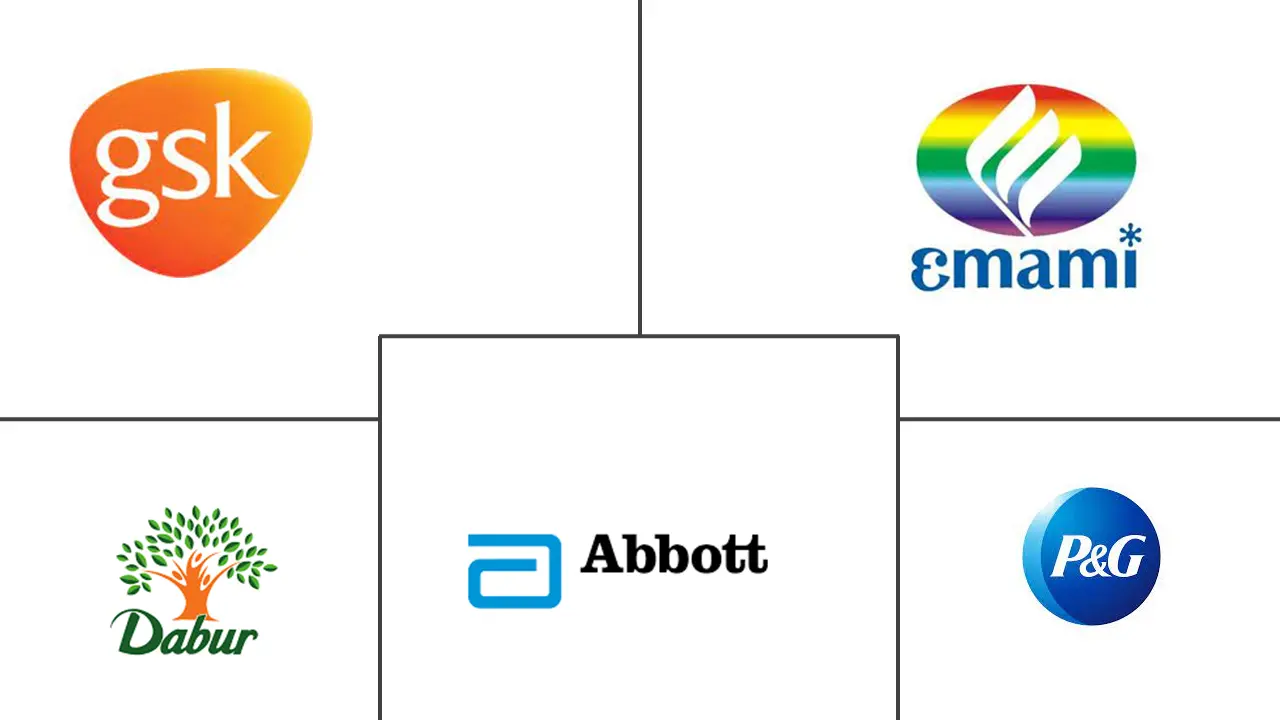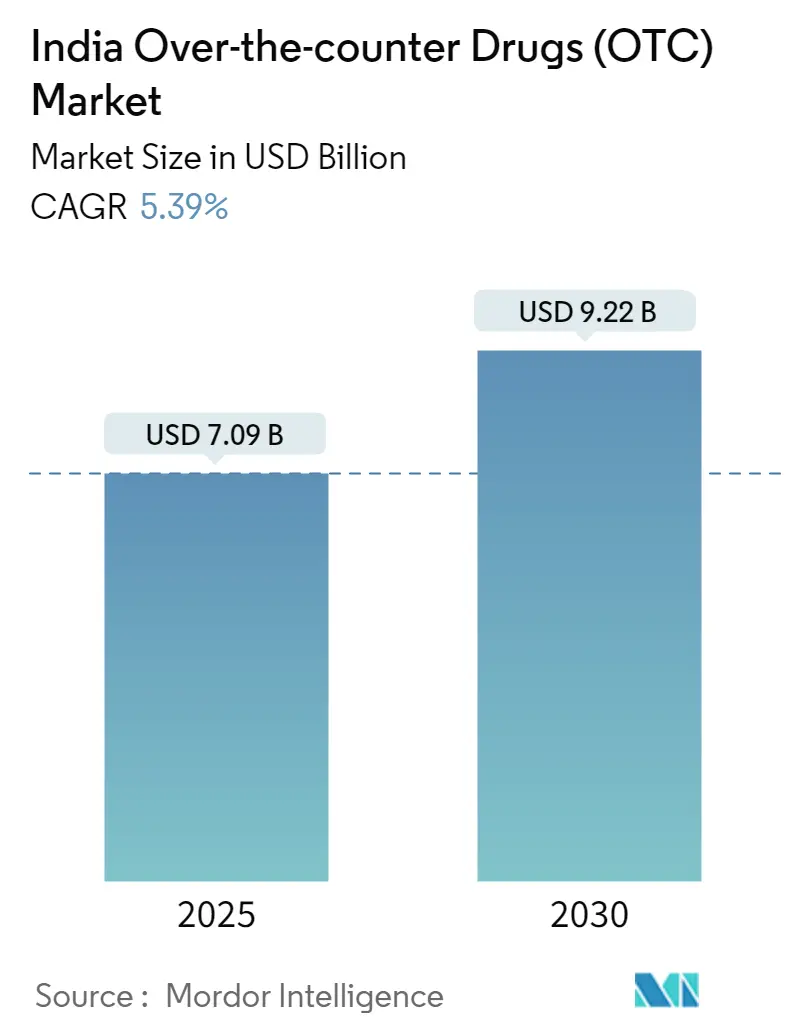
India Over-the-counter Drugs (OTC) Market Analysis by Mordor Intelligence
The India Over-the-counter Drugs Market size is estimated at USD 7.09 billion in 2025, and is expected to reach USD 9.22 billion by 2030, at a CAGR of 5.39% during the forecast period (2025-2030).
The major factors driving the growth of the OTC drug sector include a shift toward self medication by consumers, product innovation, and the inclination of pharmaceutical companies toward OTC drugs compared to prescription drugs in the country.
Self medication is taking medicines designed and labeled for treating common health problems without a physician's prescription. Easy access, convenience, and time-saving are the most common reasons for self medication. Moreover, self-medication with over the counter drugs (non-prescription drugs) has increased in the past years owing to its advantages, such as improving accessibility. An increase in self-medication among the population in India is expected to boost the growth of the OTC drugs market during the forecast period. For instance, according to the report published by the Cureus Journal in January 2023, self-medication is rising at a significant rate in the country. The high prevalence of self-medication in the country, with 60% of individuals engaging in this practice, is significantly driving the growth of the OTC market in India. The predominant use of analgesics (66.25%) and antipyretics (59.16%) for common ailments like fever, body aches, and common colds indicates a robust demand for these products. Additionally, the inclination of individuals with education above the high school level towards self-medication underscores an expanding consumer base that perceives over the counter drugs as a convenient and time-saving solution for minor health issues.
Additionally, according to a report published by the Sage Open Medical Journal in March 2024, the high prevalence of self-medication, particularly in urban areas, is driving the growth of the India OTC market, with convenience and lack of time being key motivators. The predominant use of allopathic medicines and reliance on pharmacist recommendations highlight a consumer preference for easily accessible healthcare solutions. This trend is further supported by demographic factors such as higher self-medication rates among females and skilled workers, indicating a robust market potential for the OTC pharmaceuticals market. Hence, with the high percentage of people undergoing self-medication in India, the over the counter drugs market is expected to grow rapidly during the forecast period.
However, price cuts for various active pharmaceutical ingredients, restrictions for advertising, and lack of stringent regulations for over the counter drugs in India are expected to hinder the market's growth during the study period.
India Over-the-counter Drugs (OTC) Market Trends and Insights
The Analgesics Segment is Expected to Witness Significant Growth During the Forecast Period
- The growth of over-the-counter (OTC) drugs in the analgesics segment is driven by a rise in the number of individuals affected by headaches, fever, toothache, musculoskeletal injuries, disorders, menstrual cramps, and product launches by key market players. The issues related to pain are significant reasons for the self medication of analgesics, as these drugs are readily available and can be bought without a doctor's prescription.
- The growing trend of self medication with OTC analgesics in the Indian population is expected to increase market growth during the forecast period. For instance, according to a report published by the Patient Preference and Adherence Journal in June 2023, the high prevalence of self-medication (SM) with non-opioid analgesics (NOA) is driving the growth of the OTC analgesic segment in India. This trend underscores the increased demand for easily accessible and perceived safe pain management solutions, such as paracetamol, which is widely used despite potential risks, thus expanding market opportunities for OTC analgesic manufacturers. The rising trend of self medication with OTC analgesics and the launch of new products are projected to boost the market's growth.
- Similarly, for diseases such as headaches and fever, the patient prefers self medication rather than going to the doctor to save the time and cost required to visit a physician/hospital. Consumers depend on over the counter drugs for headaches and fevers as the first response for quick relief from symptoms. Owing to their ease in procurement and surging market demand, the sale of OTC drugs for analgesics is increasing in India. For instance, according to the data updated by the Indian government in November 2023, the units sold of OTC drugs belonging to the analgesics family increased by 23% compared to 2022.
- Moreover, key players in the market are also working on introducing novel growth strategies to cater to the rising demand for analgesics in the India OTC market. For instance, in March 2024, Himalaya Wellness Company started working on its digital platform to bolster its presence and drive growth in the OTC segment. Himalaya Wellness Company offers a diverse platform of OTC products like analgesics and cough and cold remedies.
- In conclusion, the increasing trend of self medication with OTC analgesics among the population, owing to its various benefits, such as cost, time-saving, and product launches, is expected to contribute to OTC segment growth in India during the forecast period.
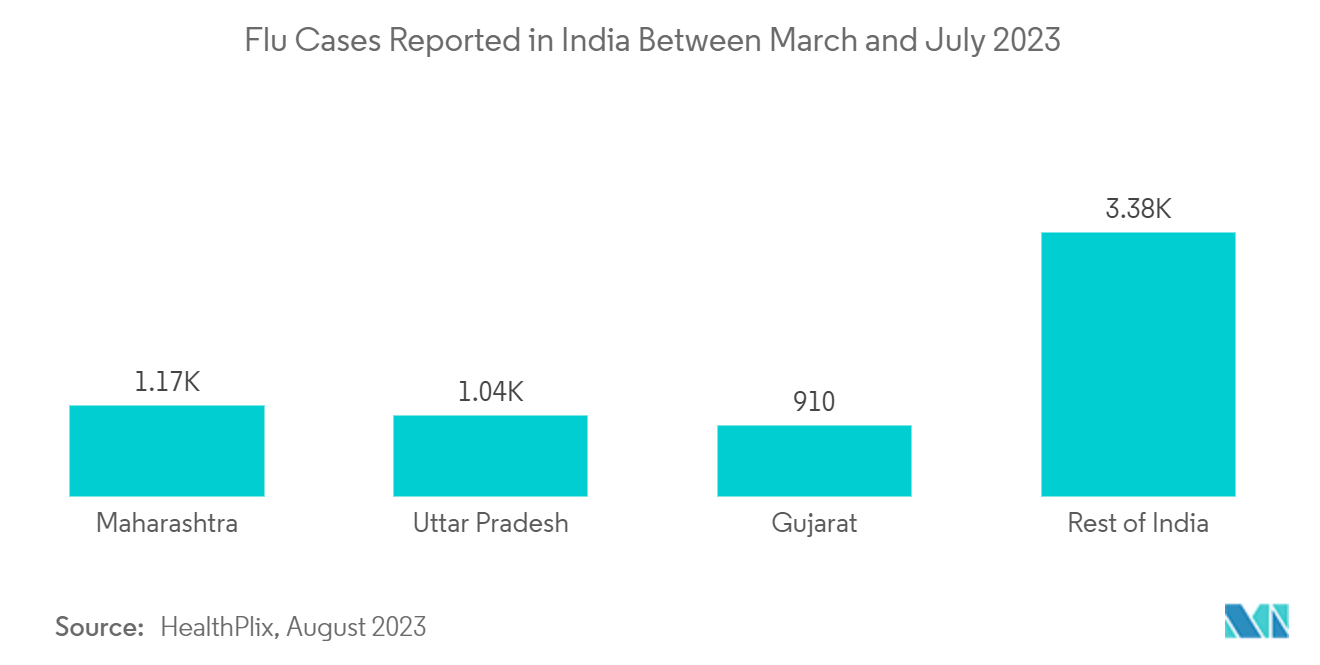
Cough, Cold, and Flu Products Segment is Expected to Hold a Significant Share in the Market During the Forecast Period
- The landscape of cough, cold, and flu diseases in India has expanded significantly owing to a surge in the prevalence of flu diseases over recent decades, which has resulted in a considerable medical and economic burden, thereby creating a substantial opportunity within the over the counter market in India.
- Factors such as rising cases of flu, the surge in demand for over-the-counter cough and flu treatments, and a rising shift toward self medication are propelling the growth of the over-the-counter flu treatments in the country's market.
- The government is working on various initiatives to increase the availability of medications to the general population, which is expected to boost the growth of the flu products segment in the country. For instance, according to a report published by the Government of India in December 2023, the Pradhan Mantri Bhartiya Janaushadhi Pariyojana (PMBJP) sold over INR 1,000 crore (USD 119.74 million) worth of OTC medicines in 2023.
- Similarly, in May 2024, the central drug regulatory authorities of the country under the Union Health Ministry are working on launching a new initiative where OTC drugs will be available in general shops. The move is aimed at making commonly occurring drugs more accessible and affordable, especially for the poor and households in remote areas. The government's initiatives to increase medication availability include expanding the reach of OTC drugs and making them available in general shops, as well as enhancing accessibility and affordability for the population. This improved access is driving the growth of the gastrointestinal products segment in India.
- Major players in the market are also working on novel growth strategies to cater to the rising demand for over-the-counter flu medicines in the country. For instance, in May 2024, Micro Labs informed that it was planning to expand its medicinal offering market brand extensions, including Dolo 500, Dolo Pain Relief Gel, Dolo Spray, Dolosils cough lozenges, and other OTC products like skin ointments, nicotine gum, and ORS. Such initiatives by key players are expected to propel the growth of the market during the forecast period.
- In conclusion, the significant rise in flu prevalence and government initiatives to enhance medication accessibility are driving substantial growth in the Indian over the counter drugs market, bolstered by strategic expansions from major market players.
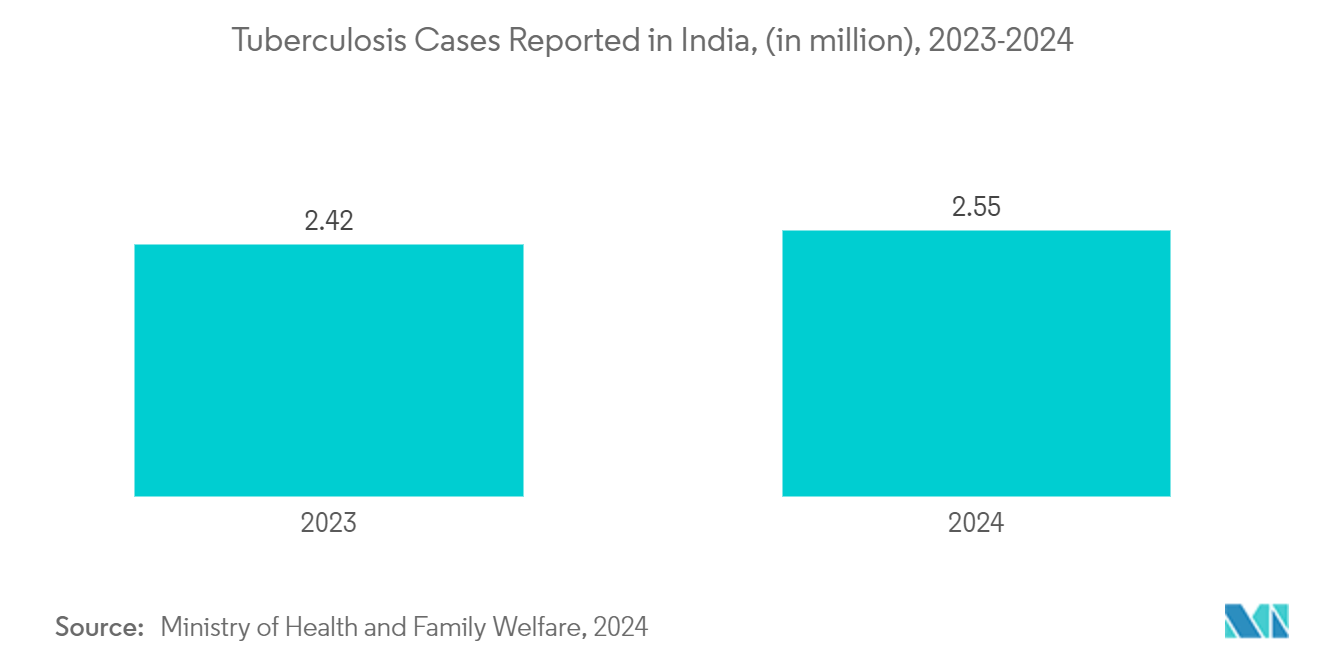
Competitive Landscape
The Indian over-the-counter (OTC) drugs market is competitive in nature, with several leading OTC pharma companies operating in the sector. The industry players are focusing on new product developments and acquisition strategies to gain market shares. Additionally, the key players have been involved in various strategic alliances, such as acquisitions and collaborations, with the launch of advanced products to secure their position in the market. The major OTC pharmaceutical companies in the market are Emami Limited, Dabur India Limited, Proctor & Gamble, Abbott Laboratories, and GlaxoSmithKline PLC.
India Over-the-counter Drugs (OTC) Industry Leaders
Emami Limited
Dabur India Limited
Procter & Gamble
Abbott Laboratories
GlaxoSmithKline PLC
- *Disclaimer: Major Players sorted in no particular order
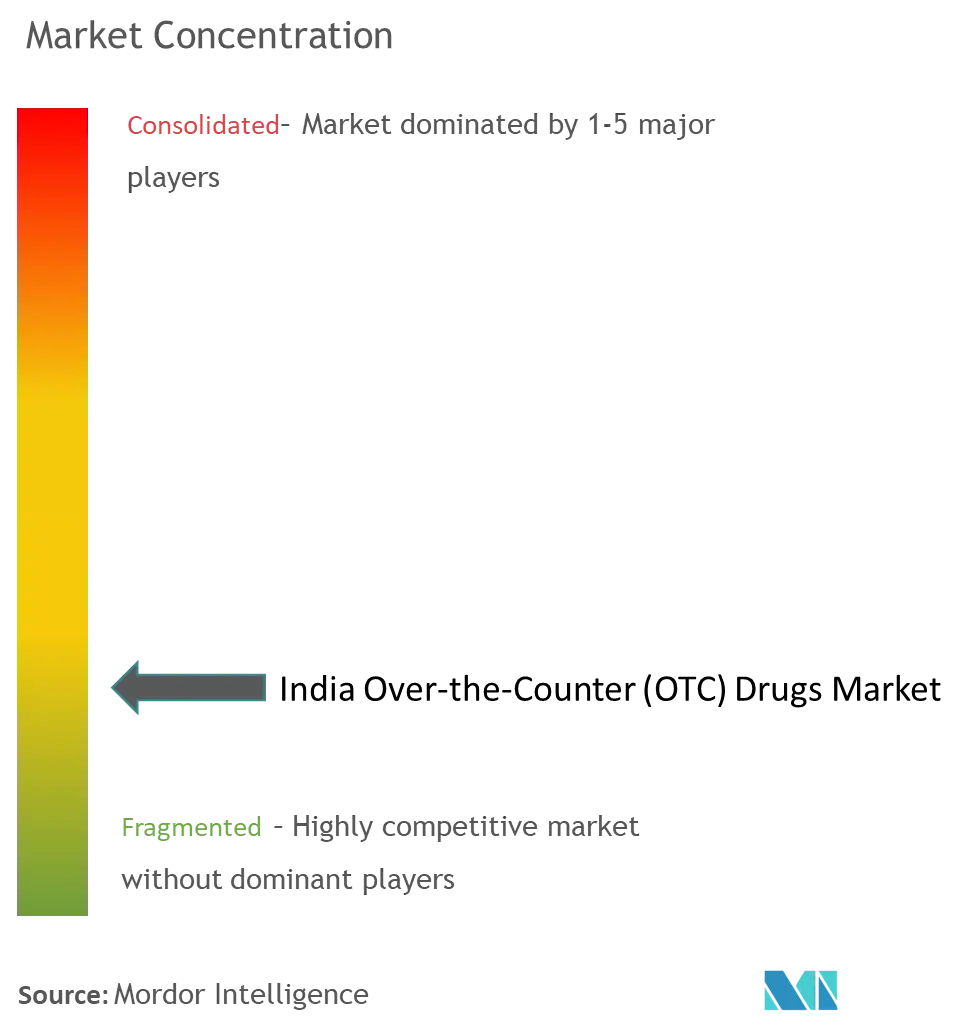
Recent Industry Developments
- April 2024: Nestle India and Dr Reddy’s Laboratories Ltd entered a definitive agreement to form a joint venture to bring innovative nutraceutical brands to consumers in India and other agreed territories. Dr Reddy’s has licensed brands such as Rebalanz, Celevida, Antoxid, Kidrich-D3, and Becozinc in the nutrition and OTC (over-the-counter) segments.
- March 2024: Emcure Pharmaceuticals launched its new over-the-counter (OTC) product, Galact, and entered the OTC market.
India Over-the-counter Drugs (OTC) Market Report Scope
As per the scope of the report, over-the-counter drugs are referred to as non-prescription drugs. These medicines can be bought by individuals without a doctor's prescription and are safe for consumption without the doctor's consent. The Indian over-the-counter (OTC) drug market is segmented by product and distribution channel. The product segment is further divided into cough, cold, and flu products, analgesics, dermatology products, gastrointestinal products, vitamins, minerals, and supplements (VMS), and other products. By distribution channel, the market is further segmented into hospital pharmacies, retail pharmacies, and other distribution channels. The report offers the value (USD) for the above segments.
| Cough, Cold, and Flu Products |
| Analgesics |
| Dermatology Products |
| Gastrointestinal Products |
| Vitamins, Minerals, and Supplements (VMS) |
| Other Products |
| Hospital Pharmacies |
| Retail Pharmacies |
| Other Distribution Channels |
| By Product | Cough, Cold, and Flu Products |
| Analgesics | |
| Dermatology Products | |
| Gastrointestinal Products | |
| Vitamins, Minerals, and Supplements (VMS) | |
| Other Products | |
| By Distribution Channel | Hospital Pharmacies |
| Retail Pharmacies | |
| Other Distribution Channels |
Key Questions Answered in the Report
How big is the India Over-the-counter Drugs Market?
The India Over-the-counter Drugs Market size is expected to reach USD 7.09 billion in 2025 and grow at a CAGR of 5.39% to reach USD 9.22 billion by 2030.
What is the current India Over-the-counter Drugs Market size?
In 2025, the India Over-the-counter Drugs Market size is expected to reach USD 7.09 billion.
Who are the key players in India Over-the-counter Drugs Market?
Emami Limited, Dabur India Limited, Procter & Gamble, Abbott Laboratories and GlaxoSmithKline PLC are the major companies operating in the India Over-the-counter Drugs Market.
What years does this India Over-the-counter Drugs Market cover, and what was the market size in 2024?
In 2024, the India Over-the-counter Drugs Market size was estimated at USD 6.71 billion. The report covers the India Over-the-counter Drugs Market historical market size for years: 2021, 2022, 2023 and 2024. The report also forecasts the India Over-the-counter Drugs Market size for years: 2025, 2026, 2027, 2028, 2029 and 2030.
Page last updated on:
India Over-the-counter Drugs (OTC) Market Report
The India OTC drugs market is experiencing significant growth, marked by an increasing geriatric population, enhanced health awareness, and a rise in self-medication. This expansion is further supported by e-commerce pharmacies' popularity and field advancements, coupled with government efforts toward making OTC drugs more accessible and affordable. The shift toward self-treatment, influenced by high medical consultation fees and an aging population prone to various health conditions, is crucial in driving the demand for OTC products. Moreover, continuous innovations in product development alongside the strengthening of online sales avenues are anticipated to boost market growth. The market is also witnessing substantial R&D investments, leading to the launch of innovative products designed to meet the demands for efficient, reliable, and cost-effective healthcare solutions, signifying a promising outlook for the sector. Statistics for the OTC Drugs in India market share, size and revenue growth rate, created by Mordor Intelligence™ Industry Reports. OTC Drugs in India analysis includes a market forecast outlook and historical overview. Get a sample of this industry analysis as a free report PDF download.
